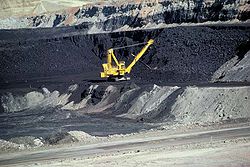- Non-renewable resource
-
A non-renewable resource is a natural resource which cannot be produced, grown, generated, or used on a scale which can sustain its consumption rate, once depleted there is no more available for future needs. Also considered non-renewable are resources that are consumed much faster than nature can create them. Fossil fuels (such as coal, petroleum, and natural gas), types of nuclear power (uranium) and certain aquifers are examples. In contrast, resources such as timber (when harvested sustainably) or metals (which can be recycled) are considered renewable resources.[1]
Contents
Fossil fuel
Natural resources such as coal, petroleum, oil and natural gas take thousands of years to form naturally and cannot be replaced as fast as they are being consumed. Eventually natural resources will become too costly to harvest and humanity will need to find other sources of energy.
At present, the main energy source used by humans are non-renewable fossil fuels, as a result of continual use since the first internal combustion engine in the 17th century, the fuel is still in high demand with conventional infrastructure fitted with the combustion engine.
Radioactive fuel
The use of nuclear technology requires radioactive fuel. Uranium ore is present in the ground at relatively low concentrations and mined in 19 countries.[2] The uranium resource is used to create plutonium,[3] uranium-238 is fissionable and can be transmuted into fissile plutonium-239 in a nuclear reactor. Nuclear fuel is used for the production of nuclear weapons and in nuclear power stations to create electricity. Nuclear power provides about 6% of the world's energy and 13–14% of the world's electricity.[4] Nuclear technology is a volatile and contaminating source of fuel production, with the expense of the nuclear industry predominantly reliant on subsidies. The radioactive waste the nuclear industry collects is highly hazardous, for a prolonged period and storage has risks of containment. Radioactive fuel continues to be controversial and unresolved industry.
Renewable resources
Natural resources, called renewable resources, are replaced by natural processes and forces of the natural environment. There are intermittent and reoccurring renewables, and recyclable materials, which are utilised during a cycle across a certain amount of time, and can harness any number of cycles. Soil, water, forests, plants, and animals are all renewable resources as long as they are adequately conserved. Solar, wind, wave, and geothermal energies are based on renewable resources. Renewable resources such as the movement of water (hydropower, tidal power and wave power from ocean surface waves), wind (used for wind power), geothermal heat (used for geothermal power); and radiant energy (used for solar power) are practically infinite and cannot be depleted, unlike their non-renewable counterparts, which are likely to run out if not used sparingly.
Potential wave energy on our coastlines, can provide 1/5 of world demand. Hydroelectric power can supply 1/3 of our total energy global needs. Geothermal energy can provide 1.5 more times the energy we need. There is enough wind to power the planet 30 times over, wind power could power all of humanity's needs alone. Solar currently supplies only 0.1% of our world energy needs, but there is enough out there to power humanity's needs 4,000 times over, the entire global projected energy demand by 2050.[5][6]
Economic models
In economics, a non-renewable resource is defined as a good where greater consumption today implies less consumption tomorrow.[7] David Ricardo in his early works analysed the pricing of exhaustible resources, where he argued that the price of a mineral resource should increase over time. He argued that the spot price is always determined by the mine with the highest cost of extraction, and mine owners with lower extraction costs benefit from a differential rent. The first model is defined by Hotelling's rule, which is a 1931 economic model of non-renewable resource management by Harold Hotelling. It shows that efficient exploitation of a nonrenewable and nonaugmentable resource would, under otherwise stable conditions, lead to a depletion of the resource. The rule states that this would lead to a net price or "Hotelling rent" for it that rose annually at a rate equal to the rate of interest, reflecting the increasing scarcity of the resources. The Hartwick's rule provides an important result about the sustainability of welfare in an economy that uses non-renewable source.
See also
- Clean technology
- Energy conservation
- Fossil water
- Green design
- Hermann Scheer
- Hubbert's peak
- Liebig's law of the minimum
- Overfishing
- Peak oil
References
- ^ On site renewable energy options
- ^ "World Uranium Mining". World Nuclear Association. http://www.world-nuclear.org/info/inf23.html. Retrieved 2011-02-28.
- ^ "What is uranium? How does it work?". World Nuclear Association. http://www.world-nuclear.org/education/uran.html. Retrieved 2011-02-28.
- ^ World Nuclear Association. Another drop in nuclear generation World Nuclear News, 05 May 2010.
- ^ R. Eisenberg and D. Nocera, "Preface: Overview of the Forum on Solar and Renewable Energy," Inorg. Chem. 44, 6799 (2007).
- ^ P. V. Kamat, "Meeting the Clean Energy Demand: Nanostructure Architectures for Solar Energy Conversion," J. Phys. Chem. C 111, 2834 (2007).
- ^ Cremer and Salehi-Isfahani 1991:18
External links
Categories:- Resources
- Natural resources
- Non-renewable resources
- Conservation
Wikimedia Foundation. 2010.


